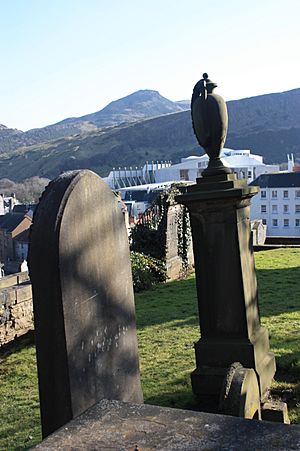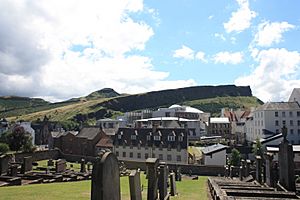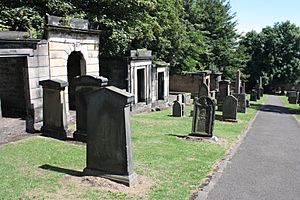New Calton Burial Ground facts for kids

The New Calton Burial Ground is a historic cemetery in Edinburgh, Scotland. It was built to help with the growing need for burial space in the city. You can find it on Regent Road, on the south-east side of Calton Hill. It's also very close to the Canongate area in Edinburgh's Old Town. From the cemetery, you get great views of famous landmarks like Holyrood Palace, the Scottish Parliament Building, and Arthur's Seat.
One special part of the cemetery is the Stevenson family plot. This is where several important members of the family of the famous writer Robert Louis Stevenson are buried.
Contents
Why Was New Calton Burial Ground Built?
The New Calton Burial Ground was needed because of a big construction project. Between 1817 and 1820, a new road called Waterloo Place was built. This road cut right through the older Old Calton Burial Ground. Because of this, many bodies and their gravestones had to be carefully moved to a new location. This new location became the New Calton Burial Ground.
It was a huge job to identify and move up to 300 people. This is why you might see some gravestones in New Calton Burial Ground that are older than the cemetery itself! The new cemetery was made much larger than just for these moved graves. Edinburgh was growing fast in the early 1800s, and more space was needed for burials.
Both the Old and New Calton burial grounds were not private cemeteries. They were public burial grounds for people from the Calton area who worshipped in Leith. Since Leith was quite a distance, these cemeteries were a convenient place for burials closer to home.
The architect who designed the road that cut through the Old Calton Burial Ground was Archibald Elliot. He is actually buried in the New Calton Burial Ground. The New Calton Burial Ground itself was first designed by Thomas Bonnar, and then finished by Thomas Brown.
The very first person buried here (who wasn't moved from the old cemetery) was John Fyfe. He died in 1817 and was buried in his father's new vault. The cemetery officially "opened to the public" in 1820, after all the reburials were finished.
How the Cemetery is Laid Out
The design of the New Calton Burial Ground is thought to have been done by Thomas Brown. He was the Superintendent of Works for Edinburgh at the time.
You'll find the oldest gravestones along the very northern edge of the cemetery. Some entire burial vaults were even rebuilt here.
The cemetery is mostly laid out in straight lines. It has several terraces that step down the hill from east to west.
The Watch-tower
Near the entrance, at the top corner of the cemetery, there's a special watch-tower. This tower was built to protect the graves from "graverobbers." In the past, some people would dig up bodies to sell them for medical study. The watch-tower helped prevent this.
Interestingly, a family lived in this tiny tower from the mid-1800s until about 1955. Even though it's only about 5 meters wide inside, it's said that a family of ten once lived there! They used nearby empty plots of land as gardens to grow vegetables.
Current Condition of the Cemetery
Today, the grass in the New Calton Burial Ground is well looked after. However, some of the gravestones are broken or have been damaged. Many have also been laid flat by the local authorities for safety reasons.
In June 2019, some tombs and monuments in the cemetery were unfortunately vandalized.
Famous People Buried Here
Many interesting and important people are buried in the New Calton Burial Ground. Here are a few:
- Rev George Husband Baird (1761–1840): He was the head of the University of Edinburgh.
- David Bryce (1803–1876): A well-known architect.
- William Dick (1793–1866): A famous vet who started the Dick Vet College in Edinburgh.
- Archibald Elliot (1760–1823): The architect who designed Waterloo Place, which led to the creation of this cemetery.
- John Inglis, Lord Glencorse (1810–1891): A politician and judge.
- William Knox (Scottish poet) (1789–1825): A poet who was a favorite of Abraham Lincoln.
- William MacGillivray (1796–1852): A naturalist who studied plants and animals.
- Robert Stevenson (civil engineer) (1772–1850): A famous lighthouse engineer. His son, Thomas Stevenson (1818–1887), who was also a lighthouse engineer and the father of Robert Louis Stevenson, is also buried here.
- Roger Hale Sheaffe (1763–1851): A General.
Other notable graves include:
- A Commonwealth War Grave for five sailors from the merchant navy. Their bodies were found after their ship, the MV Atheltemplar, was attacked during World War II in 1941.
- Four war graves from World War I, including soldiers and airmen.
- The well-built vault of David Gall, who was a coachbuilder.
- The interesting carvings on the vault of Andrew Grierson (died 1847).
Fun Facts About the Cemetery
- Sometimes, the cemetery is called "The Cemetery of the Admirals." However, this name isn't very common, and the cemetery actually has fewer admirals buried here than many other cemeteries in Edinburgh.
- Many of the gravestones that were moved from Old Calton Cemetery belonged to "tanners" and "leather workers." This shows how important shoemaking was in that area long ago.
Images for kids







